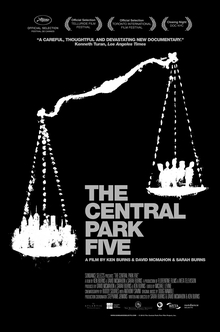Miranda v. Arizona, 384 U.S. 436 (1966), was a landmark decision of the U.S. Supreme Court in which the Court ruled that law enforcement in the United States must warn a person of their constitutional rights before interrogating them, or else the person's statements cannot be used as evidence at their trial. Specifically, the Court held that under the Fifth Amendment to the U.S. Constitution, the government cannot use a person's statements made in response to an interrogation while in police custody as evidence at the person's criminal trial unless they can show that the person was informed of the right to consult with a lawyer before and during questioning, and of the right against self-incrimination before police questioning, and that the defendant not only understood these rights but also voluntarily waived them before answering questions.

The Central Park jogger case was a criminal case concerning the assault and rape of Trisha Meili, a woman in Central Park in Manhattan, New York, on April 19, 1989. On the night of the attack, dozens of teenagers had entered the park, and there were reports of muggings and physical assaults.
The Reid technique is a method of interrogation. The system was developed in the United States by John E. Reid in the 1950s. Reid was a polygraph expert and former Chicago police officer. The technique is known for creating a high pressure environment for the interviewee, followed by sympathy and offers of understanding and help, but only if a confession is forthcoming. Since its spread in the 1970s, it has been widely utilized by police departments in the United States.

Sture Ragnar Bergwall, also known as Thomas Quick from 1993–2002, is a Swedish man previously believed to have been a serial killer, having confessed to more than 30 murders while detained in a mental institution for personality disorders. Between 1994 and 2001, Quick was convicted of eight of these murders. However, he withdrew all of his confessions in 2008. As a result, his murder convictions were quashed, the final one in July 2013, and he was released from hospital. The episode raised issues about how murder convictions could have been obtained on such weak evidence, and has been called the largest miscarriage of justice in Swedish history. Journalists Hannes Råstam and Jenny Küttim and Dan Josefsson published TV documentaries and books about the murder cases; they claimed that bad therapy led to false confessions. Dan Josefsson claims that a "cult"-like group led by psychologist Margit Norell manipulated the police and talked Sture Bergwall into false confessions.

Within the criminal justice system of Japan, there exist three basic features that characterize its operations. First, the institutions—police, government prosecutors' offices, courts, and correctional organs—maintain close and cooperative relations with each other, consulting frequently on how best to accomplish the shared goals of limiting and controlling crime. Second, citizens are encouraged to assist in maintaining public order, and they participate extensively in crime prevention campaigns, apprehension of suspects, and offender rehabilitation programs. Finally, officials who administer criminal justice are allowed considerable discretion in dealing with offenders.
A false confession is an admission of guilt for a crime which the individual did not commit. Although such confessions seem counterintuitive, they can be made voluntarily, perhaps to protect a third party, or induced through coercive interrogation techniques. When some degree of coercion is involved, studies have found that subjects with highly sophisticated intelligence or manipulated by their so-called "friends" are more likely to make such confessions. Young people are particularly vulnerable to confessing, especially when stressed, tired, or traumatized, and have a significantly higher rate of false confessions than adults. Hundreds of innocent people have been convicted, imprisoned, and sometimes sentenced to death after confessing to crimes they did not commit—but years later, have been exonerated. It was not until several shocking false confession cases were publicized in the late 1980s, combined with the introduction of DNA evidence, that the extent of wrongful convictions began to emerge—and how often false confessions played a role in these.
In the law of criminal evidence, a confession is a statement by a suspect in crime which is adverse to that person. Some secondary authorities, such as Black's Law Dictionary, define a confession in more narrow terms, e.g. as "a statement admitting or acknowledging all facts necessary for conviction of a crime," which would be distinct from a mere admission of certain facts that, if true, would still not, by themselves, satisfy all the elements of the offense. The equivalent in civil cases is a statement against interest.

Murder on a Sunday Morning is a 2001 documentary film directed by Jean-Xavier de Lestrade. The documentary centers around the Brenton Butler case, in which a fifteen-year-old African-American boy was wrongfully accused of murder in Jacksonville, Florida. The film follows Butler's public defense attorneys as they piece together the narrative and how the police coerced Butler into confessing. It received critical acclaim and won the Academy Award for Best Documentary Feature at the 74th Academy Awards in 2002.
The murder of 12-year-old Stephanie Crowe took place in her bedroom inside her home at Escondido, California, sometime between late night January 20, 1998, to early morning January 21, 1998. Stephanie's parents and grandmother found her body on the floor of her bedroom on the morning of January 21, 1998. She had been stabbed eight times. There was no sign of forced entry. Stephanie's window was found unlocked, but a screen was in place and there was no disturbance of accumulated grime and insect traces. A sliding glass door in her parents' bedroom was also unlocked. No knives were found at the scene that seemed consistent with the murder weapon, and no bloody clothing was found despite an exhaustive search.
The Norfolk Four are four former United States Navy sailors: Joseph J. Dick Jr., Derek Tice, Danial Williams, and Eric C. Wilson, who were wrongfully convicted of the 1997 rape and murder of Michelle Moore-Bosko while they were stationed at Naval Station Norfolk. They each declared that they had made false confessions, and their convictions are considered highly controversial. A fifth man, Omar Ballard, confessed and pleaded guilty to the crime in 2000, insisting that he had acted alone. He had been in prison since 1998 because of violent attacks on two other women in 1997. He was the only one of the suspects whose DNA matched that collected at the crime scene, and whose confession was consistent with other forensic evidence.
Saul Kassin is an American academic, who serves as a professor of psychology at the City University of New York's John Jay College of Criminal Justice and Massachusetts Professor Emeritus of Psychology at Williams College in Williamstown, Massachusetts.
Iwao Hakamada is a Japanese former professional boxer who was sentenced to death on September 11, 1968, for a 1966 mass murder that became known as the Hakamada Incident. On March 10, 2011, Guinness World Records certified Hakamada as the world's longest-held death row inmate. In March 2014, he was granted a retrial and an immediate release when the Shizuoka district court found there was reason to believe evidence against him had been falsified.

The Brenton Butler case was a murder case in Jacksonville, Florida. During the investigation of a shooting death outside a motel in 2000, police arrested 15-year-old Brenton Butler and charged him with the murder. Butler subsequently confessed to the crime, and the case went to trial. However, during the trial he testified that he had been brutalized into his confession, and he was acquitted. The case gained significant notice in the media, and became the subject of an award-winning documentary, Murder on a Sunday Morning.
Mr. Big is a covert investigation procedure used by undercover police to elicit confessions from suspects in cold cases. Police officers create a fictitious grey area or criminal organization and then seduce the suspect into joining it. They build a relationship with the suspect, gain their confidence, and then enlist their help in a succession of criminal acts for which they are paid. Once the suspect has become enmeshed in the criminal gang, they are persuaded to divulge information about their criminal history, usually as a prerequisite for being accepted as a member of the organization.

The Central Park Five is a 2012 documentary film about the Central Park jogger case, directed by documentary filmmaker Ken Burns, his daughter Sarah Burns, and her husband David McMahon. It covers the arrests, interrogations, trials, convictions and vacating the convictions of the five men who were teenagers in 1989 at the time of the case. It was released in the US on November 23, 2012.
Adrian P. Thomas was a father of seven children living in Troy, New York, when, in September 2008, his four-month-old son died. A preliminary medical examination indicated that the infant died from head trauma. The police interrogated Thomas for nearly 10 hours during which he confessed to throwing his son on the bed three times. The entire interrogation was videotaped. He was charged with second-degree murder, found guilty, and sentenced to 25 years to life in prison.
In the early hours of August 10, 1991, a mass shooting occurred at Thai Buddhist temple Wat Promkunaram in Waddell, Arizona, killing nine people. At the time, this was the deadliest mass shooting at a place of worship in U.S. history, until it was paralleled by the Charleston church shooting in 2015, which also killed nine people, and then superseded by the Sutherland Springs church shooting in Texas in 2017. As of 2024, it is the deadliest mass shooting in Arizona history.
Brendan Ray Dassey is an American convicted murderer from Manitowoc County, Wisconsin, who at 16 confessed to being a party to first-degree murder, mutilation of a corpse, and second-degree sexual assault. He was sentenced to life in prison with the earliest possibility of parole in 2048. His videotaped interrogation and confession, which he recanted before trial, substantially contributed to his conviction. Parts were shown, but much was left out, in the Netflix documentary series Making a Murderer (2015). The series examined the 2005–2007 investigation, prosecution, and trials of Dassey and his uncle, Steven Avery, both of whom were convicted of murdering the photographer Teresa Halbach on October 31, 2005.
The Confession Tapes is a true crime television documentary series that presents several cases of possible false confessions leading to murder convictions of the featured people. In each case, the documentary presents alternate views of how the crime could have taken place and features experts on false confessions, criminal law, miscarriages of justice and psychology. The series, produced and distributed by Netflix, became available to all Netflix subscribers on September 8, 2017. Critics praised the series, likening it to other Netflix true crime documentaries, such as The Keepers and Making a Murderer.
Four-year-old Kevin Hjalmarsson was found dead in Arvika, Sweden on 16 August 1998. Two brothers, then five and seven years old, were accused of murdering him and were claimed to have confessed. The brothers were extensively investigated and interrogated, but they were never charged with a crime.






